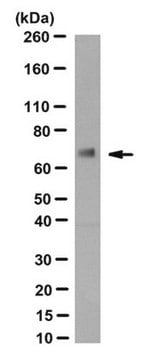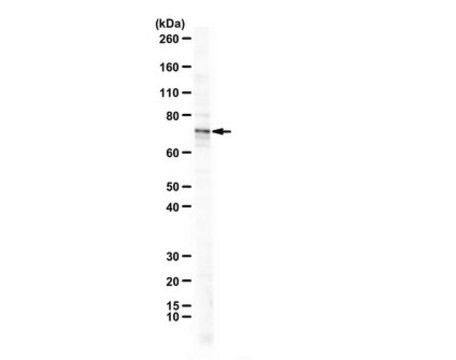MABF3038
Anti-Rhinovirus Capsid VP1 Antibody, clone HRV-18003
Synonym(e):
HRV-capsid VP1
About This Item
Empfohlene Produkte
Biologische Quelle
mouse
Qualitätsniveau
Antikörperform
purified antibody
Antikörper-Produkttyp
primary antibodies
Klon
HRV-18003, monoclonal
Mol-Gew.
calculated mol wt 242.824 kDa
observed mol wt ~32 kDa
Aufgereinigt durch
using protein G
Speziesreaktivität
virus
Verpackung
antibody small pack of 100
Methode(n)
ELISA: suitable
inhibition assay: suitable
western blot: suitable
Isotyp
IgG2aκ
Epitopsequenz
N-terminal half
Protein-ID-Hinterlegungsnummer
UniProt-Hinterlegungsnummer
Lagertemp.
-10 to -25°C
Spezifität
Immunogen
Anwendung
Evaluated by Western Blotting with recombinant Rhinovirus Capsid VP1 protein.
Western Blotting Analysis: A 1:125 dilution of this antibody detected recombinant Rhinovirus Capsid VP1 protein.
Tested Applications
Functional Assay A representative lot of this antibody exhibited strong activity in in vitro antibody dependent cellular phagocytosis (ADCP) assay. (Behzadi, M.A., et al. (2020). Sci Rep.;10(1):9750).
Western Blotting Analysis: A representative lot detected HRV-18003 recognizes VP1 in Western Blotting applications (Behzadi, M.A., et al. (2020). Sci Rep.;10(1):9750).
ELISA Analysis: A representative lot detected HRV-18003 recognizes VP1 in ELISA applications (Behzadi, M.A., et al. (2020). Sci Rep.;10(1):9750).
Note: Actual optimal working dilutions must be determined by end user as specimens, and experimental conditions may vary with the end user.
Zielbeschreibung
Physikalische Form
Rekonstituierung
Lagerung und Haltbarkeit
Sonstige Hinweise
Haftungsausschluss
Not finding the right product?
Try our Produkt-Auswahlhilfe.
Lagerklassenschlüssel
12 - Non Combustible Liquids
WGK
WGK 2
Flammpunkt (°F)
Not applicable
Flammpunkt (°C)
Not applicable
Analysenzertifikate (COA)
Suchen Sie nach Analysenzertifikate (COA), indem Sie die Lot-/Chargennummer des Produkts eingeben. Lot- und Chargennummern sind auf dem Produktetikett hinter den Wörtern ‘Lot’ oder ‘Batch’ (Lot oder Charge) zu finden.
Besitzen Sie dieses Produkt bereits?
In der Dokumentenbibliothek finden Sie die Dokumentation zu den Produkten, die Sie kürzlich erworben haben.
Unser Team von Wissenschaftlern verfügt über Erfahrung in allen Forschungsbereichen einschließlich Life Science, Materialwissenschaften, chemischer Synthese, Chromatographie, Analytik und vielen mehr..
Setzen Sie sich mit dem technischen Dienst in Verbindung.








